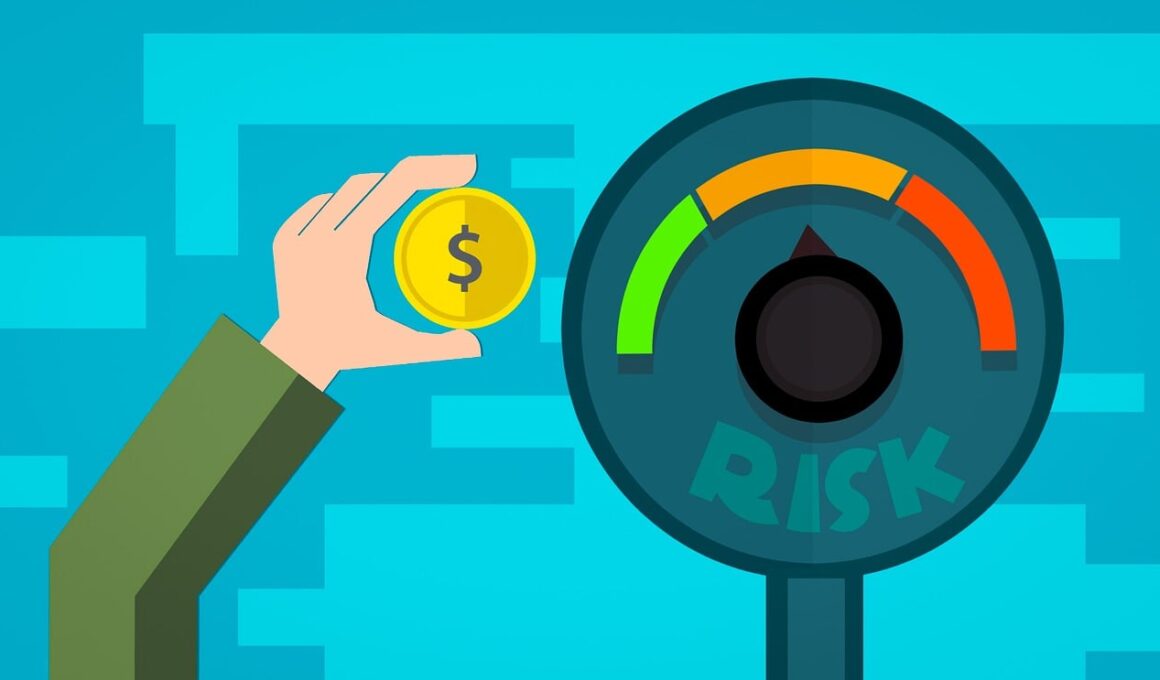Risk Management Strategies in Commodity Trading
In the volatile realm of commodity trading, effective risk management strategies are indispensable for mitigating losses. Traders must understand various factors that influence commodity prices, including supply-demand dynamics, geopolitical events, and economic indicators. Market volatility can arise from unexpected developments, leading to significant financial impact. Consequently, adopting strategies such as diversification, hedging, and futures contracts is critical. By spreading investments across various commodities, traders can reduce exposure to any single asset’s price fluctuations. Additionally, hedging against adverse price movements through financial derivatives can safeguard profits and minimize risks. Implementing stop-loss orders serves to limit losses by automatically selling a commodity at a predetermined price. This proactive approach allows traders to manage unexpected downturns effectively. Risk tolerance levels must align strategically with individual trading goals to maintain a balanced portfolio. Continuous market analysis and staying informed about economic trends also contribute to effective risk management. Traders can employ tools like technical analysis to anticipate price movements and adapt their strategies accordingly. Interspersing short-term trading with long-term holdings further promotes a coherent and resilient trading strategy that mitigates danger. Awareness of these fundamentals is vital for enduring success in commodity markets.
Sound market research forms the backbone of effective commodity trading strategies. Traders must delve into not just price charts, but also fundamental analyses that set the foundation for informed decision-making. Understanding production levels, inventory data, and seasonal trends is crucial for anticipating price movements accurately. In addition to hard data, keeping abreast of international news and policy developments can provide valuable insights into market trends. Incorporating macroeconomic indicators such as inflation rates and currency fluctuations into analysis enhances traders’ risk assessments. It’s essential to identify market sentiment as well, as psychological factors can significantly sway commodity prices. Implementing data analytics and software tools allows traders to sift through massive amounts of information swiftly, facilitating better predictions and strategies. Risk management doesn’t merely revolve around the numbers, but includes the emotional and psychological elements that can affect judgment. Establishing a clear trading plan helps in navigating through the psychological highs and lows of trading. By setting realistic goals and strictly adhering to predetermined plans, traders can maintain discipline and minimize impulsive decisions driven by fear or greed. Systematic trading can also incorporate performance reviews for continuous improvement and learning iterations.
The Importance of Hedging in Commodity Trading
Hedging plays an essential role in risk management within commodity trading, protecting traders from adverse price movements leading to potential losses. By adopting various hedging techniques, traders can create a safety net around their investments. For instance, futures contracts can lock in prices for products that will be delivered in the future, ensuring profitability regardless of market fluctuations. Options contracts also offer traders the flexibility to purchase or sell commodities at predetermined prices, further allowing risk mitigation. Additionally, forward contracts serve as private agreements between buyers and sellers, enabling traders to customize terms and conditions that benefit their individual risk management strategies. The effectiveness of hedging depends heavily on proper implementation and understanding of the market conditions influencing commodity prices. Traders must also balance the costs and benefits associated with hedging strategies, ensuring that potential gains outweigh expenses. Furthermore, achieving diversification through hedging isn’t solely about financial instruments; a mix of commodities can collectively enhance risk profiles. For example, a portfolio comprising agricultural products and precious metals can cushion against sector-specific downturns. Over time, effective hedging can stabilize returns, allowing traders to pursue aggressive strategies with less fear of overwhelming losses.
Another crucial aspect of risk management in commodity trading revolves around setting and adhering to a budget and financial limits. Financial discipline is paramount; it ensures that traders do not engage in reckless trading fueled by emotional impulses. Establishing a trading budget involves calculating the maximum amount one is willing to risk on any single trade. This budget should be well thought out, factoring trading goals, financial reserves, and overall market conditions. Utilizing a proper position sizing strategy is vital in limiting exposure and protecting capital. Traders can make calculated decisions regarding how much commodity to buy or sell, aligning this with their managerial capacities. Furthermore, using just a portion of the trading account for each trade minimizes the risks associated with market volatility. Keeping detailed records of trades and outcomes enables traders to analyze performance over time and make data-driven adjustments. Reviewing past trades offers insights into what strategies were successful and which were not, providing a pathway for ongoing learning. By creating a meticulous approach to budgeting, traders can maintain focus on their strategies and avoid derailing their progress by emotional decision-making, thus enhancing long-term success.
Emotional Control and Psychology in Trading
The psychological aspect of trading commodities cannot be overstated. Emotional control becomes a vital component in managing risk effectively in high-stakes environments. Traders often face immense pressure and uncertainty when dealing with volatile markets, which can lead to rash decisions. Addressing psychological traps such as overconfidence, loss aversion, and fear is crucial to ensure effective decision-making. Developing mental resilience allows traders to remain focused on long-term objectives rather than immediate outcomes. Utilizing strategies such as mindfulness and self-reflection can improve emotional regulation. Maintaining a trading journal serves as both a record of decisions made and a tool for emotional reflection. This can help traders identify patterns in their behavior, prompting adjustments to mitigate risks associated with emotional trading. Sticking to a concrete trading plan helps cultivate discipline. Once a trader commits to specific strategies, the reliance on sound logic over whimsy aids in maintaining consistent performance. Traders may also benefit from mentorship and educational resources to strengthen their understanding of both market dynamics and personal psychology. Ultimately, recognizing the significance of emotional factors can play a larger role in forming effective risk management strategies moving forward.
Technological advancements have transformed risk management strategies in commodity trading by introducing sophisticated tools and methods. Automated trading systems and artificial intelligence have revolutionized how traders analyze data and execute trades. These tools provide immediate access to real-time market data, facilitating better-informed decisions. Algorithms integrated within these platforms can help predict market movements, reducing the time traders spend on manual analyses. Utilizing technology allows traders to streamline their operations and focus on refining strategies. Additionally, mobile trading applications enable traders to manage their investments on-the-go, adjusting positions whenever necessary without being tied to a physical location. Furthermore, back-testing capabilities simulate various trading strategies against historical data to evaluate effectiveness. This process enhances traders’ confidence in their approaches, all while fine-tuning risk parameters. Cybersecurity emerges as another key consideration; safeguarding financial data is imperative in an increasingly digital ecosystem. Enhancing online security via encryption and two-factor authentication measures protects traders against breaches and fraud. Knowing that their investments are secured encourages traders to engage in more calculated risks. Hence, embracing technology becomes a vital ingredient for traders aiming to optimize their risk management strategies while navigating the fast-paced commodity markets.
Conclusion: Building a Comprehensive Risk Management Strategy
The establishment of a comprehensive risk management strategy for commodity trading encompasses various pivotal elements. Combining diversification, hedging, disciplined trading, emotional control, and technology leads to a more robust framework against losses. Traders should prioritize ongoing education and skill enhancement to adapt to evolving market conditions continually. Engaging in constant performance evaluation and willingness to adapt strategies fosters resilience amid market volatility. By solidifying financial limits and utilizing proper budgeting strategies, traders lay the groundwork for sustainable trading practices. Utilizing risk management will not only protect traders from potential downturns, but also enable them to seize growth opportunities in profitable conditions. Accepting that losses are a part of trading and developing a plan to cope with them is crucial for long-term strategy formulation. Ultimately, a well-rounded approach that incorporates experiences, financial discipline, and continuous learning will fortify traders against the unpredictable nature of commodity markets. By staying committed to structured risk management, traders can cultivate a sustainable and profitable trading experience that promises to prevail through shifting market tides. Continuous application and refinement of these practices can ensure longevity in the dynamic landscape of commodity trading.
In summary, understanding and implementing multiple risk management strategies are crucial elements for any trader engaged in the commodity markets. Factors such as technological advancements, market research, hedging techniques, psychological training, and rigorous financial management contribute to overall trading effectiveness. By embracing these strategies, traders can navigate through uncertainties, maximizing profits while minimizing potential losses. Constant learning and adapting to market conditions will pave the way for achieving sustained growth and resilience in the competitive trading arena. The key to success lies not just in trading acumen but in a comprehensive understanding of the risk landscape.


